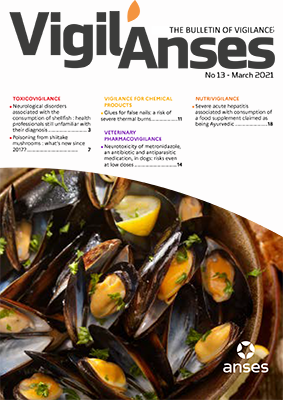Issue 13 OF VIGIL'ANSES
Editorial

While cases of food poisoning with digestive signs following the consumption of shellfish are widely known, many people are unaware that some forms can cause neurological signs. The first article of this Issue 13 of Vigil’Anses describes this phenomenon, which can involve mussels, oysters or other bivalves contaminated by marine neurotoxins.
The very first issue of Vigil’Anses had drawn consumers’ attentions to the risk of skin reactions associated with the consumption of raw or undercooked shiitake mushrooms. Four years later, a new overview of these particular cases of poisoning is presented in this issue. Have communication campaigns been effective?
Applying your own false nails at home may seem safe. However, the cyanoacrylate glues used pose a risk of severe skin burns if they get on clothes in contact with the skin. Following two cases reported to Poison Control Centres, the third article of this issue addresses this phenomenon.
Metronidazole is an antibiotic and antiparasitic medication used in dogs, alone or in combination with spiramycin. As scientific articles have described neurological adverse effects at lower doses than previously known, the French Agency for Veterinary Medicinal Products analysed reports recorded in the national veterinary pharmacovigilance database to look for this type of effect and learn about the circumstances of its occurrence. The results are given in this issue.
The last article reports a new example of a serious adverse effect, recorded by the nutrivigilance scheme, occurring following the consumption of a food supplement. It involved a case of severe acute hepatitis associated with consumption of the SriSri Kanchanara® food supplement; the company placing this product on the market claims that it relates to the practice of Ayurvedic medicine. A causal relationship was considered very likely.
Juliette Bloch, Editor-in-Chief of Vigil'Anses

